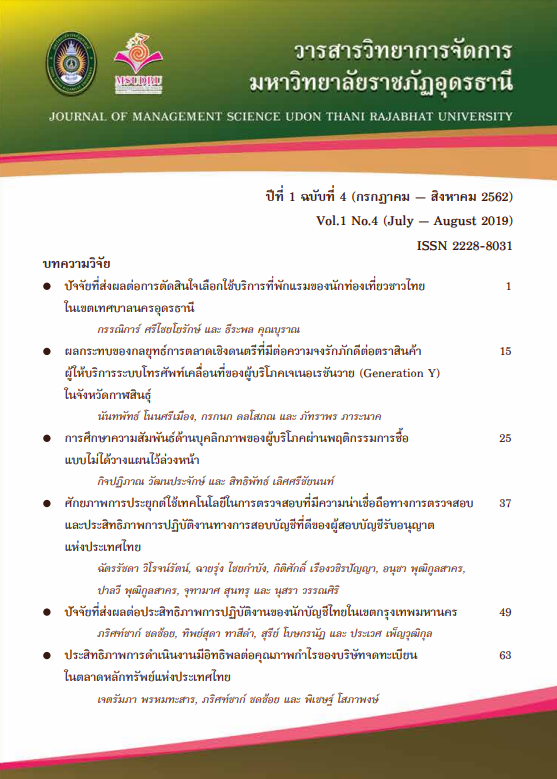THE STUDY ON THE INFLUENCE OF CUSTOMERS’ PERSONALITY TOWARD CUSTOMERS’ UNPLANNED BUYING BEHAVIOR
Main Article Content
Abstract
This purposes of this research were to explore the factors concerning customers’ personality affecting unplanned buying behavior toward brand personality. The respondents were customers from shopping at local trade fairs. 330 samples had to provide the information in the closed-end questionnaire on their personalities and unplanned buying behavior. Originally, the types of personality could be divided into 42 types. Then, exploratory factor analysis was used to analyze the data with Principal component analysis as well as the orthogonal rotation with Varimax rotation method. The findings revealed five personality traits; modernist, self-image, positive thinker, humble and self-indigence, respectively. Multiple regression analysis reported the personalities influencing unplanned buying behavior with R Square = 0.177. The results showed only self-image and self-indulgence influenced on unplanned buying tendency 71.2 and 22.4 percent, respectively. In contrast, modernist group showed the results on buying impulsively in the different direction which equal to 41.9 percent. The results from the research can be applied for the business by finding effective marketing tools to motivate unplanned buying to the self-image and self-indulgence customers.
Article Details

This work is licensed under a Creative Commons Attribution-NonCommercial-NoDerivatives 4.0 International License.
บทความที่ได้รับการตีพิมพ์เป็นลิขสิทธิ์ของคณะวิทยาการจัดการ มหาวิทยาลัยราชภัฏอุดรธานี
ข้อความที่ปรากฏในบทความแต่ละเรื่องในวารสารวิชาการเล่มนี้ ไม่ใช่ความคิดเห็นและความรับผิดชอบของผู้จัดทำ บรรณาธิการ กองบรรณาธิการ และคณะวิทยาการจัดการ มหาวิทยาลัยราชภัฏอุดรธานี ความรับผิดชอบด้านเนื้อหาและการตรวจร่างบทความแต่ละเรื่องเป็นความคิดเห็นของผู้เขียนบทความแต่ละท่าน
References
กันยา สุวรรณแสง. (2533). การพัฒนาบุคลิกภาพ.กรุงเทพมหานคร: กรุงเทพฯ: บํารุงสาสน์.
ทิชากร เกษรบัว. (2559). การวิเคราะห์องค์ประกอบเชิงสำรวจปัจจัยที่มีอิทธิพลต่อการตัดสินใจซื้อบริการโทรทัศน์ผ่านดาวเทียมของผู้ใช้บริการในเขตกรุงเทพมหานคร. วารสารวิชาการ คณะบริหารธุรกิจ มหาวิทยาลัยเทคโนโลยีราชมงคลธัญบุรี, 11(2), 59-72.
นงลักษณ์ วิรัชชัย. (2538). ความสัมพันธ์โครงสร้างเชิงเส้น (Lisrel) สถิติวิเคราะห์สำหรับการวิจัยทางสังคมศาสตร์และพฤติกรรมศาสตร์. พิมพ์ครั้งที่ 2. กรุงเทพฯ: จุฬาลงกรณ์มหาวิทยาลัย.
วาจาสิทธิ์ ลอเสรีวาณิช. (2548). เอ็นเนียแกรม-ศาสตร์เพื่อความเขาใจตนเองและผูอื่น. กรุงเทพฯ: มูลนิธิโกมลคีมทอง.
วีระ ไชยศรีสุข. (2533). สุขภาพจิต. พิมพ์ครั้งที่ 2. กรุงเทพฯ: แสงศิลป์การพิมพ์.
ศรัณย์ อมาตยกุล และ ก่อพงษ์ พลโยราช. (2559). บุคลิกภาพตราสินค้า. วารสารนักบริหาร, 36(2), 89-101.
Aaker, J. L. (1997). Dimensions of brand personality. Journal of Marketing Research, 34(3), 347-356
Asadollahi, A., H., K. H., Abdolvand, M. A., and Reshadatjooh, H. (2015). The new brand personality model in IRAN. International Journal of Scientific Management & Development, 3(2), 838-843.
Bloom, B. S. (1956). Taxonomy of Education. Hand Book I: Cognitive Domain, New York: David McKay.
Bosnjak, M., Bochmann, V., & Hufschmidt, T. (2007). Dimensions of brand personality attributions: A person-centric approach in the German cultural context. Social Behavior and Personality: an International Journal, 35(3), 303-316.
Briggs, K. C. (1987). Myers-Briggs type indicator. Form G. Palo Alto. California: Consulting Psychologists.
Kim, J. O., Mueller, C. W. (1978). Factor Analysis: Statistical Methods and Practical Issues. Beverly Hills, CA: Sage.
Krejcie, R. V., & Morgan, D. W. (1970). Determining Sample Size for Research Activities. Educational and Psychological Measurement, Vol.30, 607-610
Plummer, J. T. (1985). How personality makes a difference. Journal of Advertising Research, 24(6), 27-31.
Rook, D. W., and Robert, J. F. (1995). Normative Influences on Impulsive Buying Behavior. Journal of Consumer Research, Vol. 22, 305-313.
WP. (2017). ทำความเข้าใจ “จิตวิทยาพฤติกรรมการซื้อ” เคล็ดลับแบรนด์ชนะใจลูกค้า ในยุคไร้ Brand Loyalty สืบค้นเมื่อ 1 พฤษภาคม 2662 จาก https://www.brandbuffet.in.th/2017/08/the-psychology-of-consumer/
Youn, S., and Faber, R. J. (2000). Impulse Buying: Its Relation to Personality Traits and Cues. Advances in Consumer Research, Vol. 27, 179-185.

